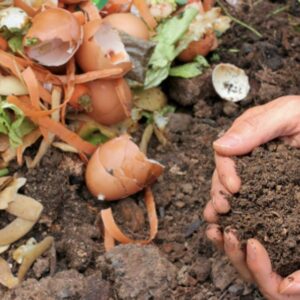During holiday celebrations with friends and family we tend to generate more waste than usual—which is alarming, considering the daily average is already 4.9 pounds per person in the U.S. Food scraps make up the biggest share of our waste sent to landfills, where it generates the potent greenhouse gas methane, rather than returning to the soil in the form of compost. But the status quo doesn’t need to stay the same, as there are plenty of ways to reduce and recycle our waste without dampening our holiday cheer. In fact, solutions like giving experiences as gifts instead of stuff, smarter meal prep, making use of leftovers, and knowing what to compost can actually contribute to feelings of togetherness and merriment.
When it comes to composting, luckily more options are becoming accessible every year. BioCycle magazine estimates that 14.9 million U.S. households, or roughly 12% of the population, now have access to either curbside or drop-off composting programs that accept food scraps. For those of us that do not live in a city offering these services, there are other alternatives. Options like composting in a backyard (which builds healthy soil right at home for flower beds and gardens) or signing up for one of the more than 100 compost subscription services around the country are readily available.

With many states passing laws that require food scraps to be diverted from disposal, we can expect residential access to composting to continue to grow. On the west coast, states like California and Washington have passed aggressive mandates that require jurisdictions to offer organic waste collection to businesses and households (SB1383 and HB1799, respectively), whereas on the east coast most of the policy updates have focused on the largest generators of food waste like supermarkets and stadiums.
When composting your food scraps, it’s important to take a number of factors into consideration. Make sure to remove all contaminants, even the small stickers on fruits, which are challenging to screen out and often end up in the finished compost. Depending on your community’s guidelines, you may be able to add food-soiled paper and certified compostable packaging directly to your compost collection but be sure to check the list for what’s accepted, and check whether the items are actually certified compostable, such as in BPI’s searchable database.
It can be difficult to sort through countless eco-friendly disclaimers on products and packaging, which is why a handful of states, including California, Washington, Maryland, Colorado, and Minnesota, have passed laws forbidding misleading terms that could imply an item will biodegrade in a landfill or if littered, and requiring compostability claims to be supported by testing to independent standards. In some cases, these laws prescribe specific colors for compostable items and other mechanisms to make them more readily identifiable. There’s a growing effort to try and standardize these laws so that labeling on compostable products is more uniform, such as with a policy principles document from BPI and the US Composting Council, building alignment between the producers and receivers of these materials.

While best practices for recycling are much more widely known, for composting, remember the saying, “when in doubt, throw it out.” Instead of wishcycling an item into the compost or recycling bin, throw it out if you are not sure where it belongs. This is particularly important for composting because unlike with recyclables — where items are sent to a facility for sorting — food scraps and packaging typically remain mixed when they are composted, making it very challenging to identify and remove contamination once it’s thrown in the bin. For programs that accept BPI certified compostable products, that mixture is processed together to create a high-quality compost.
Regarding other holiday waste in question, when choosing how to wrap gifts, consider options that can be reused, recycled, or composted instead of thrown away after one use. The things that make some wrapping paper highly ornamental, like metallic designs or glitter, also make these products not readily recyclable or compostable. Plain kraft paper, while not eye-catching on its own, can be recycled and composted, and can be dressed up with colorful ribbons and bows, which in turn can be reused for future presents (my family has a small box of ribbons and bows that have been saved from previous years). Similarly, ornamental gift bags can be a great option for reuse and regifting (they collapse flat for storage), but keep in mind that just like wrapping paper, the shiny elements mean these bags may not be recyclable and should not be composted.
When it comes to decorations, luckily many people already have a tradition of reuse, like ornaments for the tree, strings of lights, and lawn decorations. For holiday greenery, most communities offer seasonal collection or drop-off programs for old Christmas trees and wreathes, grinding them into mulch or adding them to compost piles. In fact, the National Christmas Tree Association (yes, that’s a thing!) estimates there are more than 4,000 of these tree recycling programs in the United States. It’s important to make sure you’ve removed all ornaments, lights, tinsel, garland, etc. from the trees and wreathes first. Other options include choosing an artificial tree or wreath that can be reused for decades with proper care, or a live tree with a root ball if you have space in your yard.
As we wind down and prepare for the new year, hopefully we can find joy in being resourceful, which at its core is being grateful for what we have.
